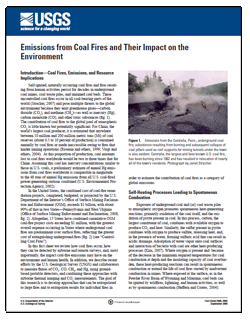Emissões da queima de carvão e seu impacto sobre o meio ambiente / Emissions from Coal Fires and Their Impact on the Environment

Introduction
Self-ignited, naturally occurring coal fires and fires resulting from human activities persist for decades in underground coal mines, coal waste piles, and unmined coal beds. These uncontrolled coal fires occur in all coal-bearing parts of the world (Stracher, 2007) and pose multiple threats to the global environment because they emit greenhouse gases—carbon dioxide (CO2), and methane (CH4)—as well as mercury (Hg), carbon monoxide (CO), and other toxic substances (fig. 1). The contribution of coal fires to the global pool of atmospheric CO2 is little known but potentially significant. For China, the world’s largest coal producer, it is estimated that anywhere between 10 million and 200 million metric tons (Mt) of coal reserves (about 0.5 to 10 percent of production) is consumed annually by coal fires or made inaccessible owing to fires that hinder mining operations (Rosema and others, 1999; Voigt and others, 2004). At this proportion of production, coal amounts lost to coal fires worldwide would be two to three times that for China. Assuming this coal has mercury concentrations similar to those in U.S. coals, a preliminary estimate of annual Hg emissions from coal fires worldwide is comparable in magnitude to the 48 tons of annual Hg emissions from all U.S. coal-fired power-generating stations combined (U.S. Environmental Protection Agency, 2002).
In the United States, the combined cost of coal-fire remediation projects, completed, budgeted, or projected by the U.S. Department of the Interior’s Office of Surface Mining Reclamation and Enforcement (OSM), exceeds $1 billion, with about 90% of that in two States—Pennsylvania and West Virginia (Office of Surface Mining Enforcement and Reclamation, 2008; fig. 2). Altogether, 15 States have combined cumulative OSM coal-fire project costs exceeding $1 million, with the greatest overall expense occurring in States where underground coal fires are predominant over surface fires, reflecting the greater cost of extinguishing underground fires (fig. 2) (see “Controlling Coal Fires”).
In this fact sheet we review how coal fires occur, how they can be detected by airborne and remote surveys, and, most importantly, the impact coal-fire emissions may have on the environment and human health. In addition, we describe recent efforts by the U.S. Geological Survey (USGS) and collaborators to measure fluxes of CO2, CO, CH4, and Hg, using groundbased portable detectors, and combining these approaches with airborne thermal imaging and CO2 measurements. The goal of this research is to develop approaches that can be extrapolated to large fires and to extrapolate results for individual fires in order to estimate the contribution of coal fires as a category of global emissions.
Kolker, Allan, Engle, Mark, Stracher, Glenn, Hower, James, Prakash, Anupma, Radke, Lawrence, ter Schure, Arnout, and Heffern, Ed, 2009, Emissions from coal fires and their impact on the environment: U.S. Geological Survey Fact Sheet 2009–3084, 4 p.
Full report PDF 1.6 MB
EcoDebate, 28/09/2009
Inclusão na lista de distribuição do Boletim Diário do Portal EcoDebate
Caso queira ser incluído(a) na lista de distribuição de nosso boletim diário, basta utilizar o formulário abaixo. O seu e-mail será incluído e você receberá uma mensagem solicitando que confirme a inscrição.
 |
| Participe do grupo Boletim diário EcoDebate |
| Visitar este grupo |
Fechado para comentários.